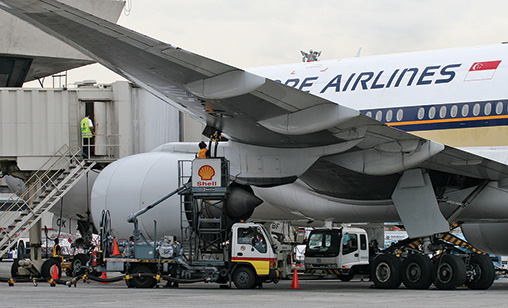Main Story
FUEL FALL FIRES UP PROFITS
Confidence among airline managements that 2015 could be one of their best twelve months for years is surging. Their optimism is driven by the dramatic plunge in the fuel price, continuing traffic growth and a revival in air freight.
February 1st 2015
Airline profit expectations for the coming year have become more positive, consistent with improvements in the industry’s recent performance, with only the Asia-Pacific reporting slower growth. Read More »
In its latest quarterly survey of airline chief financial officers and cargo heads, released in January, the International Air Transport Association (IATA) said falling costs and growth in volumes were responsible for the better financial performance, in combination with a more positive outlook for the industry’s performance.
 |
| Singapore Airlines has hedged 65.3% of its fuel needs in the six months to March, 2015, at an average price of $116 a barrel |
IATA had already lifted its profit forecast for global airlines in 2015, from $19.9 billion to $25 billion, in December, which gave the industry a global profit margin of 3.2%. Asia-Pacific operators are expected to report a net profit of $5 billion this year, up from $3.5 billion in 2014. But the fuel price level, if sustained, could lead to better projections later in the year, analysts said.
Last month, the average price for jet fuel was around $1.71 per gallon, some 18.1% lower than a month earlier and down a phenomenal 43.2%, year on year, at press time. But despite demand being largely positive, IATA cautioned that risks persist in today’s global environment, including political unrest, conflicts, and some weak regional economies.
“Nevertheless, with the global economy steadily recovering and the fall in oil prices expected to strengthen the upturn in 2015, the industry outlook is steadily improving,” IATA said.
Unusually, the downward influences on airline performance in the past few months have been in the Asia-Pacific. After a slight improvement last October, annual international traffic growth for the region’s carriers slowed to 4.9% in November, the latest period the data covers.
There is a slowdown in regional production activity, especially as China recalibrates the direction of its economy from exports to domestic sustainability, although trade volumes have remained strong.
Even if international traffic experienced a modest bounce-back in the peak December season, annual growth for Asia-Pacific carriers was expected to slow to an average of 4%, compared with global growth of 6%, said IATA.
On the other hand, the most significant freight expansion is taking place in two regions: the Asia-Pacific (up 5.9% in November) and the Middle East (up 12.9%). Carriers in these regions captured the vast majority of the global increase (93%) in air freight, with the Asia-Pacific accounting for 55% of the total year-on-year growth and a market share of 39.7%. Middle East airlines, which have 13.3% of global air cargo business, expanded their freight business by 38%.
Despite global financial services firm, Morgan Stanley, predicting oil will be as low as $43 a barrel by the third quarter of this year, the rock bottom fuel price does not guarantee more profits for some Asia-Pacific airlines.
 |
| 'The oil price collapse is “massive” for the Malaysian headquartered low-cost carrier group' |
| Tony Fernandes AirAsia group chief executive |
Analysts predicted the ultimate impact of cheaper fuel on airlines’ bottom lines will depend largely on individual carriers’ fuel hedging policies. Airlines with low hedging exposure and that are buying fuel at spot prices will reap big benefits from cheaper fuel. Airlines with a large percentage of their fuel secured by hedges at higher levels than current fuel prices will lose out unless fuel soars again.
Many Asian airlines have been cautious about hedging after they burnt their fingers in 2008. Back then, they locked in fuel costs as crude oil surged above $100 a barrel for the first time. Then oil plummeted to less than $40 per barrel before the year’s end.
As a result, many airlines suffered huge paper losses as they had to account for wrong-way fuel hedges or pay to unwind contracts prematurely. Among the big losers were Cathay Pacific Airways, which resulted in the airline’s first annual loss in more than a decade, Singapore Airlines (SIA) and the major Chinese carriers.
SIA might be at risk again. It has hedged 65.3% of its fuel needs in the six months to March, 2015, at an average price of $116 a barrel. “We do have hedges in place… and that’s going to mute the effect of lower fuel prices,” the carrier’s chief financial officer, Stephen Barnes, said at an earnings briefing last December. “On the other hand, it will protect our earnings from the full effects of a bounce if that were to happen.”
Cathay Pacific would not comment on its current hedging position, but last August its finance director, Martin Murray, said the airline had hedged 44% of projected fuel needs for 2015 at $101 a barrel of Brent crude, and 25% of its needs for 2016 and 2017 at $99 a barrel. Thai Airways International has a high percentage of its fuel hedged and is looking to increase this position using current low prices.
Analyst Shukor Yusof, founder of aviation research firm Endau Analytics, pointed out that in the last six months of 2014 very few airlines were brave enough to go into the hedging market. And if they did, it was in very small volumes. With prices dropping so fast, carriers may see buying fuel in the spot market as a far better option than the possibility of being caught on the wrong side of a long-term hedge, he said.
Another analyst, who requested anonymity, said making decisions on hedging in the current circumstances is extremely tricky, but that hedging at today’s low levels could be an excellent opportunity. He did not believe crude output would be sustained at current prices and said some increase in demand and a reduction in supply is bound to force up the price.
If the price does stay low, however, several carriers have been identified as potential beneficiaries of spot price purchases. South Korea’s Asiana Airlines halted hedging last September because of price volatility. It has hedged 8.4% of its fuel needs for this year.
A spokesman for Shanghai-based China Eastern Airlines said the carrier does not hedge.
Air India, which also goes largely unhedged, estimated it could eliminate $375 million from its annual fuel bill of about $1.5 billion, based on savings made since prices began falling eight months ago. Nevertheless, the carrier’s director of finance, S. Venkat, said Air India is looking at hedging between 30% to 40% of its fuel needs, or about 300,000 barrels a quarter, at current jet fuel prices.
Another winner could be Australia’s Qantas Airways, which has “significant scope” to benefit, according to a spokesman. About 70% of the fuel that Qantas will use in the six months to June 30, will be bought at spot prices. The remainder will be priced between current levels and higher prices prior to September 2014.
The biggest beneficiaries of cheaper fuel in the region will almost certainly be low-cost carriers, whose fuel costs represent a higher proportion of expenses than full-service carriers, at up to 50%. AirAsia group chief executive, Tony Fernandes, said the oil price collapse is “massive” for the budget carrier group.
One aspect of the fuel price change that is confronting some airlines is fuel surcharges. The public, watching prices plummet at their local service stations, question why airlines are not reducing or eliminating this charge from their air tickets.
Some airlines are doing so. Japan Airlines (JAL) has announced significant reductions from February 1. On a JAL service from the Philippines to Japan and onto the U.S. the surcharge has been cut from $259 to $173 a ticket. On other routes the reduction is as high as 50%.
Despite the reluctance of many carriers to pass on fuel savings, IATA predicted fares will fall about 5% this year, if current fuel price trends continue. Ratings agencies expected this to be mainly driven by capacity growth outstripping demand. But it is anticipated there will be some impact from the rollback of fuel surcharges in regulated markets like China.
In the Asia-Pacific, Moody’s warned a flood of capacity from start-up airlines could outstrip demand and weigh on yields and margins in the next few years. IATA forecast capacity in the region will rise by 8.5% this year, while traffic demand will expand by 7.7%.
There is another interesting development for the industry as a result of the fuel price collapse. Suddenly, hundreds of older aircraft, destined for the scrapheap, have become economically viable.
At an aircraft financier’s conference in Dublin last month, delegates were told that jets bound for the desert or scheduled to be broken up, such as A340s and older B747s, have ben given a reprieve.
“We are seeing a big pick-up in demand for aircraft we thought we would scrap,” Aengus Kelly, chief executive of lessor, AerCap, told the Airline Economics conference in Dublin. The world’s largest independent leasing company, AerCap, has recently leased out older passenger aircraft and freighters such as A340s, B747s and B757s, rather than parking them up, he said.
The potential lives of some of these older aircraft had been extended by three and four years, Kelly said. Other delegates said some airlines were retrieving mothballed B747s from desert storage to return them to flying.
However, there is universal agreement that record orders for the new generation of fuel-saving, carbon-fibre aircraft, placed as carriers sought protection from high oil prices, will stay in place.
Indeed, if low fuel costs are sustained long-term, buying a new B787, A350, B737 MAX or A320neo will be even more attractive. The current jet fuel price is about 51.1% lower than the price Boeing assumed it would be when the manufacturer calculated estimated savings of $112 million for a fleet of 100 B737 MAX 8s.
The problem is, while airlines are relieved fuel is so much cheaper, they also are aware of the volatility of oil markets and their ability to surge suddenly to higher levels.
| Asia-Pacific airline share spike IATA’s upbeat mood was underscored by ratings agency, Moody’s. In January the credit ratings agency upgraded its outlook for global airlines to “positive” from “stable” as most carriers appeared set to benefit from the sharp drop in fuel prices from June last year. Moody’s upgraded its projected profit margins for the global industry to 12%-14% for this year and 11.5% to 13.5% in 2016. This forecast is significantly higher than its previous estimate of 8.5%-9.95%. Airline shares across the Asia-Pacific shot up to their highest level in three years as the jet fuel price continued to drop. |